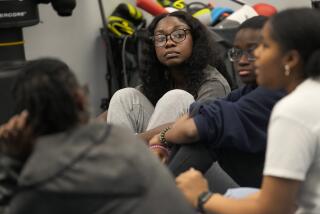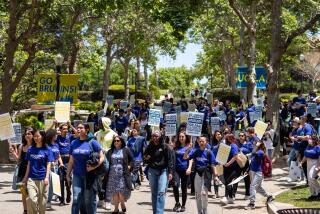Lafayette College brings its ‘hall of civil rights’ into the modern age
- Share via
Fred Morgan Kirby could not make a speech to save his life, and he told the crowd as much that day in 1930. He donned a fedora and round spectacles, and gently clasped his cane as he gazed upon the dignitaries gathered at Lafayette College.
The newly minted Kirby Hall of Civil Rights dwarfed its donor, much as the ideas of law and government it would nurture dwarfed any one man. The grand hall stood for the duties bestowed upon every (white, male) American in exchange for individual freedoms — in essence, their civil rights.
“Among the duties are the necessity of respecting the rights of others,” said Kirby, cofounder of the F.W. Woolworth Co., at the dedication ceremony. His message was emblazoned on a plaque erected in the lobby proclaiming the “Anglo-Saxon ideals of the true principles of constitutional freedom.”
During the next 80 years, a shadow settled over the granite and limestone building as “civil rights” came to mean something more. The Kirby Hall of Civil Rights became a mausoleum for an antiquated notion, and Kirby’s good intentions angered some of the very students he had hoped to inspire.
“The plaque symbolized the fact that we weren’t dealing with issues that existed on campus, and kind of ignoring them and forgetting they existed,” said Chris Nial, a former leader of the college’s gay-straight alliance who graduated last year. “It didn’t fit with our meaning of civil rights.”
Students had tried and failed to address the plaque until Nial made it a priority his senior year. He formed an unusual coalition of students — a sorority leader, two black activists and a college Democrat — to erect a second plaque putting Kirby’s comments in context.
“Lafayette knows that it’s a fairly white school, and the students on the campus know that too,” Nial said. “It’s something the campus has struggled with, and the plaque is a symbol of that. The most egregious part of it is that it doesn’t have any date or anything. It’s just this message on the wall.”
The enrollment at Lafayette, an undergraduate college of 2,400 students, is 68.5% white. The campus sits atop what’s known locally as College Hill, the highest point in Easton, a working-class city of 26,000 people an hour’s drive north of Philadelphia.
In addition to a new plaque, the student group, along with faculty and staff, installed an exhibit in the Kirby Hall lobby explaining the features and history of the building. Another display traces modern civil rights movements, from blacks to women to gays, and how they intersect with Lafayette.
The exhibit attempts to walk the fine line between updating history and rewriting it.
The college admitted its first black student in 1832, the year it opened. The institution continued to admit blacks until 1847, when administrators shut the door on diversity for the next century, Lafayette archivist Diane Shaw said.
In the 1930s, civil rights had not yet been associated with the struggle of blacks. More simply, the students explained on their plaque, the phrase referred to a vigorous debate about capitalism and socialism, individual rights to private property, and the rights of workers to organize. As for “Anglo-Saxon,” that was a product of its day.
But Lafayette, like society, did change over time. In 1947, the college broke with its history and admitted two members of the Tuskegee Airmen, the black flying unit from World War II.
One of the students was on the football team when Lafayette made the Sun Bowl in 1948. But the college hosting the game in El Paso, Texas, refused to let Lafayette compete if it allowed the black student to play. The campus protested, even sending a telegram to President Truman. Lafayette would not sideline the student and did not play.
From that point, the college continued to make strides against discrimination. A fraternity fought restrictions on accepting black students, and the college admitted its first two women in 1970. More recently, student leaders have battled homophobia, Nial said.
The changes to the Kirby Hall of Civil Rights, however, have spurred some discontent. Some students say the building should have been left alone; others say more should have been done.
In a way, they’re observing one uncontestable piece of Kirby’s advice, delivered during his dedicatory speech that May day in 1930.
“Students of Lafayette, I call on you to be individualistic, to be independent, to think for yourselves, to fear no man, to so conduct yourselves that the world will be better for you having lived.”
More to Read
Sign up for Essential California
The most important California stories and recommendations in your inbox every morning.
You may occasionally receive promotional content from the Los Angeles Times.













